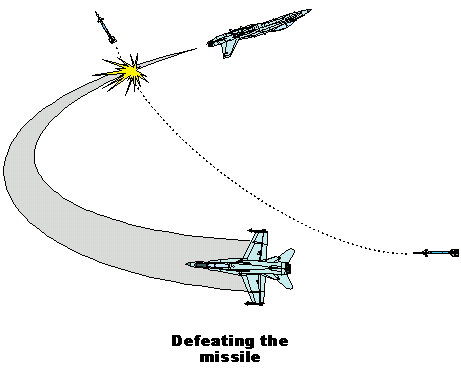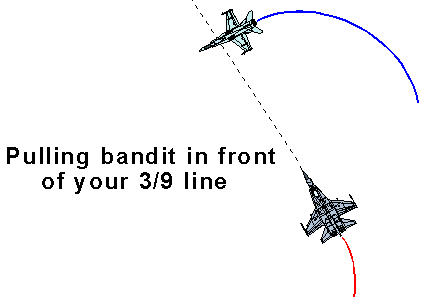- Don't reverse if you are in doubt about the overshoot.
- Reverse the turn if the bandit has a high line-of-sight rate and is within 2,000' of your flight path.
- Don't reverse the turn if the bandit is outside of 3,000' because the bandit has the ability to deal with the overshoot (turning room) and a forward 3/9 line advantage.
Defensive BFM
Well, we found ways to solve the problems created for us by the bandit. But now you are the defender and it is your turn to shake the bandit. As I said before, there are no magic maneuvers, no magic potions to help you out here. If you fly picture perfect and so does the bandit, chances are you'll still be toast. But you must first know picture perfect BFM to survive. Your best chance of survival is to fly your BFM and wait for a mistake on the bandits part. Once he makes that mistake, you must exploit it to the max. Lets talk in terms of the enemy. You have three things to fight in a battle (other than nature's forces). 1) The bandits maneuvers, 2) the bandits missiles, and 3) the bandits bullets. Remember that we are discussing 1v1 here. Now that we now what we are fighting, lets discuss them separately.
MISSILES
Lets start with the missile first as this is what you will see before you see the bandit. Once the missile leaves the rail, the bandit no longer becomes the treat. You must now defend against the missile. I have seen several comments from those flying hornet on how to defeat the missile attack, but take it from a hornet pilot, here's what you should do:
When the missile warning/SAM warning goes off, you probably have a good idea from where it originated. Turn to place the incoming missile 90 degrees off your wingtip. Again, flying at night helps to spot the missile. Keep an eye on the missile by looking left or right with the arrow keys or with your joystick (if it's programmable). Anyway, keep your speed around 300 KTS. This is about your best cornering speed. When the missile gets close (experiment), pop some chaff/flares, pull your power to idle, and execute a hard NOSE-LOW break into the missile. The other techniques may work in the game, but there is no good reason to pop your nose up, climb to 18,000 feet, and skyline yourself to the world.
Sideshow's technique is the standard missile evasion technique used in military aviation and is right on. When the missile comes off the rail, it flies the fastest pursuit course it can - lead. Remember from Definitions that flying lead pursuit will lead to an overshoot if maintained improperly. That's what we're shooting for, an overshoot. The rocket motor doesn't burn during the whole flight. Instead, it gets to speed and then burns out using it's built up smash to carry it to the target. Without the thrust behind it (remember 'e', the missile follows the same rules), hard, quick, high-g turns are hard to make. Putting the missile on your 3/9 line (also called the beam) forces the missile to constantly correct and pull max lead pursuit. You must fight the missile with aspect. Use the RWR on the HUD to find the aircraft that fired (the blinking line) and place it on the beam. When the missile gets close (I'm still trying to find the proper range myself), pop chaff/flare and pull a nose low max-g turn INTO the missile. Remember that going nose low can add an extra 2° to your turn rate. Now you must listen and watch for another. The missile does have a proximity fuse and will probably detonate with an overshoot. But if you pulled fast enough you may clear the blast. He's right about not skylining yourself - imagine a nice hot jet against a cold blue sky...

BANDIT
Now that we have defeated the missile, we must now out maneuver the bandit (guess what he was doing while you were fighting the missile?). The bandit pulls up on your six, what now? As the bandit created BFM problems for you, you must now do the same. You must now make the quickest, tightest, max-g turn you can. You must take away his turning room and deny him the maneuvering room to take the guns or missile shot. In order to do this, you must put your lift vector directly on the bandit and pull your tightest corner velocity max-g turn towards him. This will create angle-off and aspect problems immediately. This will also deny the bandit turning room into you.

First, lets discuss the bandit outside of your turn circle. Your goal here is to force the bandit in front of your 3/9 line and put him on the defensive. As you perform your turn, lift vector on the bandit, you will know almost instantly if it is working or not. The bandit should be pulling lead moving in front of your 3/9 line for a front quarter pass. Be prepared to jink out of plane to defeat a possible guns shot. With the high rate of turn and movement, this should be easy to do as the bandit will have a hard time tracking you. This should also force an overshoot (remember lead forces an overshoot).

What if the bandit started in your turn circle? You need to maintain the same philosophy. Put your lift vector on the bandit and execute your best corner velocity turn. But now the bandit is in your 'chili' and fixin' to eat you for lunch. The best defense is to try and stick the bandit in deep lag pursuit. Remember from Offensive BFM, do not try any fancy maneuvers. Stay in the fight and maintain your high-g turn. If he starts to pull closer to you, prepare for a guns defense. The purpose of all this is to maintain high aspect and angle-off. If the bandit pulls high out of plane, maintain your lift vector on the bandit. You want to force high angles again so that he can not get off the shot. This all requires that you pull the turn at corner. You must maintain the corner velocity of the jet. If the bandit pulls lead pursuit, watch out cause the lead will fly. But you can also force an overshoot if you maintain corner. If the bandit pulls pure pursuit, he has another chance at you, but you can still force an overshoot if you maintain corner. But with pure pursuit, the bandit has more of a chance of becoming the defender instead of the attacker.
If you force the overshoot, you may want to reverse your turn to pull on the bandit. This doesn't always work though. If the bandit has considerable range after the overshoot, you may not be any better off than you were before. Maintain the turn and follow through. Pick the bandit up where you left him. But if the bandit was forced ahead of your 3/9 line, you have two options: a low-g turn reversal or a high-g turn reversal. Use a low-g reversal if the bandit has a high line-of-site rate (goes quickly across your canopy). Lessen the g load on the jet, roll the jet to put your lift vector on the bandit and pull a high-g turn towards him. This should offer you a guns snapshot. Better than no shot at all. If you wish to force an overshoot that you know is going to happen, use the high-g reversal. Just roll your jet at high-g putting your lift vector on the bandit and maintain the high-g. Be careful, because if the bandit doesn't overshoot, you've just set him up for the shot - at you! Here are a few rules concerning overshoots:
BULLETS
Ok, you are fixing to be hit with lead. What do you do? There are two types of guns shots. A Snapshot refers to a quick nose-on guns shot. Snapshots are easier to defend against because the bandit is usually pulling high-g maneuvers allowing you to pull out of plane to pull away. A Tracking guns shot is harder to defend against. The bandit is usually well established on your six or even in front of you and has the chance to squeeze off several shots. To defend against the tracking shot, you must pull several out of plane maneuvers. As the bandit requires you, jink again. Maintain this until you can find away out. A jink of about 70° is usually the best.
Again, find a partner to practice with. You should both be full up and practice at different distances.